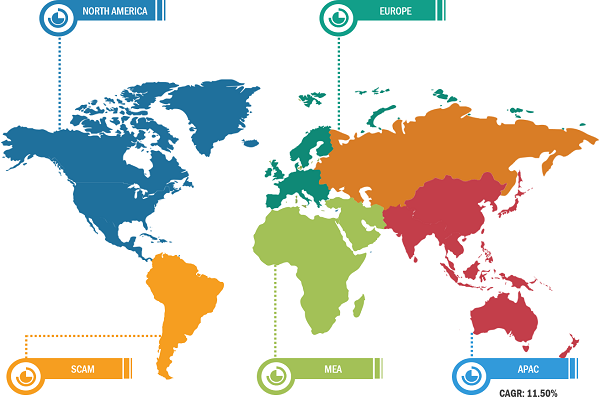Advanced Anaesthesia Monitors Product Type to Hold Largest Anesthesia Monitoring Devices Market Share During 2023–2031
According to our new research study on "Anesthesia Monitoring Devices Market Size and Forecast (2020–2030), Global and Regional Share, Trend, and Growth Opportunity Analysis," the market value is projected to grow from US$ 2,553.36 million in 2023 to US$ 5,780.94 million by 2031; the market is anticipated to record a CAGR of 10.75% from 2023 to 2031.
General anesthesia induces unconsciousness, making the patient senseless and unarousable despite painful stimuli during surgery. Anesthesia is used for dental procedures, biopsies, and other diagnostic examinations. Since the discovery of anesthetics, doctors have been able to save and extend the lives of patients. The key factors driving the anesthesia monitoring devices market growth are the introduction of various new monitoring techniques, such as monitoring the depth of anesthesia, goal-directed fluid therapy, advanced neurological monitoring, improved alarm systems, and technological advancements with an objective of pain assessment. In recent years, significant progress has been made in clinical practice development and monitoring technology. Anesthesia monitoring device trends include the rapid digitalization of anesthesia monitoring devices.
Anesthesia Monitoring Devices Market, by Region, 2023 (%)
Anesthesia Monitoring Devices Market Size and Forecast (2021 - 2031), Global and Regional Share, Trend, and Growth Opportunity Analysis Report Coverage: By Product (Basic Anesthesia Monitors, Integrated Anesthesia Workstations, and Advanced Anaesthesia Monitors), Advanced Anaesthesia Monitors (Depth of Anaesthesia Monitors, Anaesthesia Gas Monitors, and Standalone Capnograph Monitors), Technology (Bispectral Index (BIS), Auditory Evoked Potential (AEP), Patient State Index (PSI), Cortical Activity State Index (CSI), and Others), End User (Hospitals, Specialty Clinics, and Ambulatory Surgical Centers), and Geography
Anesthesia Monitoring Devices Market Forecast, Size by 2031
Download Free Sample
Product innovation plays a crucial role in shaping the market landscape of anesthesia monitoring devices, offering substantial growth, advancement, and enhanced patient care. The FDA officially authorized the PMD-200 monitor for sale in the US in March 2023. The device, developed by Medasense Biometrics, measures a patient's nociception level (NOL), or physiological reaction to pain, by tracking their heart rate, blood pressure, perspiration, and movement via a wearable finger probe. The monitor then uses machine learning to analyze the data and calculate the patient's pain threshold. Patients who are unconscious during surgery are essentially voiceless, as their NOL level speaks for them. The goal is to provide personalized care for every patient. The continuous evolution of technology, coupled with the increasing emphasis on patient safety, precision anesthesia delivery, and perioperative monitoring, drives innovation in anesthesia monitoring devices toward more advanced, efficient, and user-friendly solutions. Innovations in anesthesia monitoring encompass a wide range of developments, including portable monitoring systems, wireless connectivity for seamless data transmission, integration with electronic health records (EHRs) for streamlined documentation, advanced algorithms for data analysis and interpretation, and customizable monitoring parameters tailored to specific patient needs and surgical contexts. These innovations improve the accuracy and reliability of vital sign monitoring and enhance decision-making, anesthesia management strategies, and clinical outcomes for patients undergoing surgical procedures. Furthermore, integrating innovative features, such as artificial intelligence (AI)-driven analytics, cloud-based monitoring platforms, and smart alarms for early detection of anomalies, enables a proactive approach to anesthesia monitoring, risk mitigation, and quality improvement initiatives. Therefore, increasing product innovation is boosting the anesthesia monitoring devices market size.
On the flip side, anesthesia has various negative consequences that make patients uncomfortable and may lengthen their hospital stay and recovery, which drains them emotionally, physically, and monetarily. Minor side effects include body aches, headaches, fever, nausea, and vomiting. There may be serious adverse effects that harm the nervous system as well. As a result, the side effects of anesthesia impede the anesthesia monitoring devices market growth. Furthermore, giving general anesthesia is a complex science that can be dangerous if done incorrectly. Throughout the operation, the doses need to be changed based on the body's reaction. Thus, the lack of skilled anesthesiologists will limit the market expansion.
The anesthesia monitoring devices market forecast can help stakeholders in this marketplace plan their growth strategies. Mindray Medical International Limited; Drägerwerk AG; GE Healthcare; Koninklijke Philips N.V.; Schiller AG; Criticare Systems, Inc.; HEYER Medical AG; Infinium Medical, Inc.; Siare Engineering International Group S.r.l.; and Nihon Kohden Corporation are a few key companies profiled in the anesthesia monitoring devices market report. Companies have been implementing organic (product launches, expansions, and product approvals) and inorganic (partnerships and collaborations) strategies that contribute to their growth and lead to market progress.
The anesthesia monitoring devices market analysis has been carried out by considering the following segments: product, advanced anesthesia monitors, technology, and end user . By product, the market is classified into basic anesthesia monitors, integrated anesthesia workstations, and advanced anesthesia monitors. Based on advanced anesthesia monitors, the market is segmented into depth of anesthesia, anesthesia gas, and standalone capnograph monitors. In terms of technology, the market is classified into bispectral index, auditory evoked potential, patient state index, cortical activity state index, and others. The market is classified into hospitals, clinics, and ambulatory surgical centers based on end users. The scope of the anesthesia monitoring devices market report includes North America (the US, Canada, and Mexico), Europe (the UK, Germany, France, Italy, Spain, and the Rest of Europe), Asia Pacific (China, Japan, India, Australia, South Korea, and the Rest of Asia Pacific), the Middle East & Africa (the UAE, Saudi Arabia, South Africa, and the Rest of Middle East & Africa), and South & Central America (Brazil, Argentina, and the Rest of South & Central America). In 2023, North America held the largest anesthesia monitoring devices market share. Factors such as obesity, cardiovascular issues, and different kinds of cancer cases reported in North America will drive the number of procedures performed in the region. According to the data published by Cedars-Sinai in January 2023, over 300,000 coronary artery bypass graft surgeries, often known as bypass surgeries, were performed successfully in the US.
Contact Us
Phone: +1-646-491-9876
Email Id: sales@theinsightpartners.com